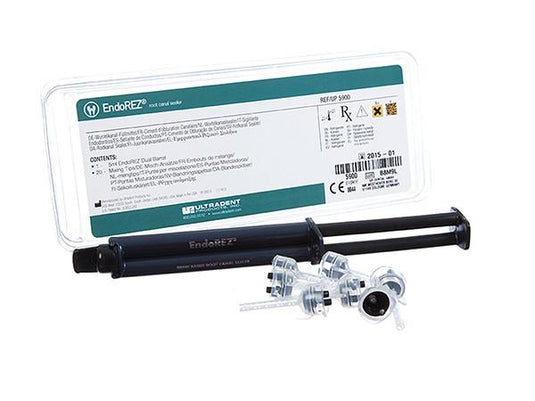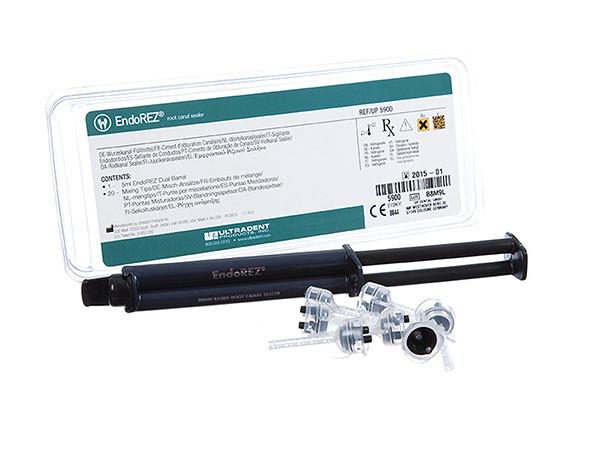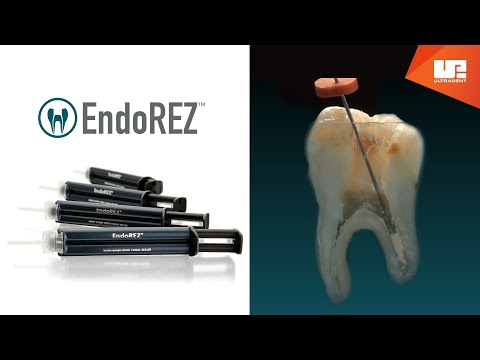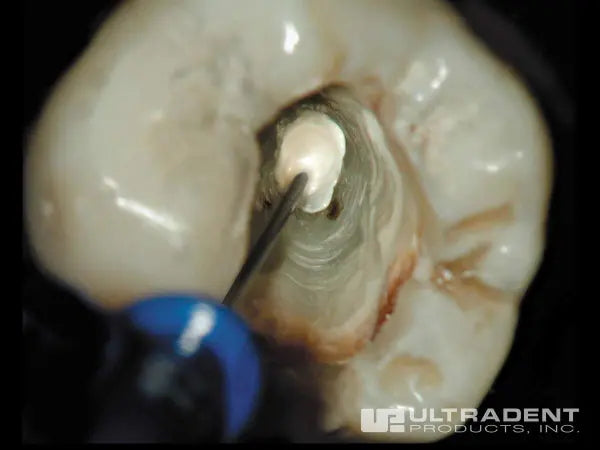


- Product Details
- Clinical Technique
- Technical Details
- Video
- Configurations
- FAQ
- Resources
- Accessories
EndoREZ canal sealer minimizes the amount of chair time required for obturation. This thixotropic material has an affinity for the moisture found deep in dentinal tubules and lateral canals,1 and provides the most complete seal available. Since methacrylate-based EndoREZ canal sealer relies on chemistry rather than heat or pressure to fill the canal, the risk of additional root trauma/fracture is greatly reduced. Additionally, studies show that EndoREZ canal sealer is versatile enough to be used as the sealer with any obturation method, e.g., master cone, lateral condensation, or warm gutta percha. Create a “monobloc” by using EndoREZ Resin-Coated Gutta Percha Points.
- The world’s first hydrophilic and self-priming resin sealer
- More effective obturation in less time
- Provides a complete, thorough seal2
- Has the same radiopacity as gutta percha
- Bonds to resin-based core/composite materials
- Retreatable when combined with gutta percha3
- Provides syringe delivery to the apical third

Indications for Use
EndoREZ canal sealer is designed to be used with EndoREZ Resin-Coated Gutta Percha Points and/or gutta percha for the filling of cleaned and shaped root canals. EndoREZ canal sealer, in conjunction with a master cone and accessory cone, provides optimum sealing. Although EndoREZ Resin-Coated Gutta Percha Points are recommended, EndoREZ canal sealer may be used with all conventional endodontic obturation techniques.



1Zmener O, Pameijer CH, Serrano SA, Vidueira M, Macchi RL. Significance of moist root canal dentin with the use of methacrylate-based endodontic sealers: an in vitro coronal dye leakage study. J Endod. 2008;34(1):76-9.
2Zmener O, Pameijer CH. Clinical and radiographic evaluation of a resin-based root canal sealer: an eight-year update. J Endod. 2010;36(8):1311-4.
3Zmener O, Banegas G, Pameijer C. Efficacy of an automated instrumentation technique in removing resin-based, zinc oxide and eugenol endodontic sealers when retreating root canal: an in vitro study. Endod Pract. 2005;8:29-33.
EndoREZ Step by Step
– See Instructions for Use for complete instructions, warnings, and precautions.
-
Fit EndoREZ gutta percha points to length. Verify radiographically.

-
Dry the canal space using the Capillary tip and Luer Vacuum Adapter, followed by paper points for 1–2 seconds each (point should be damp 1–3mm at tip). Apical delivery of EndoREZ canal sealer with NaviTip tip.

-
Using a NaviTip tip on a Skini syringe filled with EndoREZ canal sealer, insert the tip to 2–4mm short of the apex. Express the EndoREZ canal sealer while withdrawing until EndoREZ canal sealer is seen at the top of the canal. To avoid bubbles, keep end of tip buried in the EndoREZ canal sealer while withdrawing.

-
Insert the master EndoREZ gutta percha points cone to length. #25 accessory points are recommended. EndoREZ canal sealer will set in the canal in about 20–30 minutes. Sear off extraneous gutta percha and restore coronal aspect. EndoREZ canal sealer is conducive to lateral condensation or warm gutta percha techniques.

Penetrates Into Tubules Like No Other Sealer
EndoREZ canal sealer contains a special hydrophilic organophosphate methacrylate monomer that increases its hydrophilicity and produces a resin with a strong affinity for moisture with resin penetration of 1200μ into the tubules.


EndoREZ canal sealer penetrates into tubules and adapts to the walls like no other sealer on the market.
Radiopaque Results

Improved Flowability
The improved flowability of EndoREZ canal sealer allows the sealer to reach the isthmus and intercanal areas during the obturation procedure, without using any special device.






Ultradent's patented NaviTip tip delivers EndoREZ canal sealer into the entire anatomy of the canal in one step.
Time-Saving Ability
EndoREZ canal sealer gives you the ability to buy time. When used conventionally, EndoREZ canal sealer will be completely set in 30 minutes. And when used with EndoREZ Accelerator Canal Sealer, this time can be reduced to only 5 minutes. Compare this to the approximate 10-hour set time other sealers may require, and it’s clear: EndoREZ canal sealer makes every RCT faster.
Moisture Affinity
EndoREZ canal sealer contains a special hydrophilic organophosphate methacrylate monomer that increases its hydrophilicity and produces a resin with a strong affinity for moisture with resin penetration of 1200μ into the tubules.
Ultimate Adaptability
EndoREZ canal sealer is formulated with a nanoparticle-enhanced thixotropic flowability that enables EndoREZ canal sealer to adapt closely to every wall of each tubule—even the tubules in tiny lateral canals.
Chemical Obturation
EndoREZ canal sealer relies on chemistry—rather than vertical force, pressure, and heat—for complete obturation. In addition, its easy delivery with the NaviTip tips and superior wetting and handling abilities make obturations easy.
Bonds to Resin-Coated Gutta Percha
EndoREZ canal sealer bonds to the proprietary resin coating on EndoREZ gutta percha points, creating a contiguous seal between the resin and gutta percha. EndoREZ canal sealer relies on passive insertion of a gutta percha master cone and auxiliary cones. Although EndoREZ Points work well with traditional techniques, they are just as effective when used passively. Less pressure and no heat equals a lower risk of iatrogenic damage.
A Decade of Success
Over the last 10 years, EndoREZ canal sealer has been the sealer of choice in millions of root canal treatments. Years of data and numerous peer-reviewed published studies support its efficacy and long-term stability.2,4
2Zmener O, Pameijer CH. Clinical and radiographic evaluation of a resin-based root canal sealer: an eight-year update. J Endod. 2010;36(8):1311-4.
4Hammad M, Qualtrough A, Silikas N. Effect of new obturating materials on vertical root fracture resistance of endodontically treated teeth. J Endod. 2007;33(6):732-6. Epub 2007 Apr 16.
How to seal and obturate a root canal using dual cure, resin based EndoREZ and resin coated EndoREZ gutta percha points. The set time of EndoREZ can be a little as five minutes when EndoREZ accelerator is used. This is a fraction of the 8-10 hours required for other sealers on the market.
Syringe Kit (Item Number: 731100):
- 1 x 5 mL EndoREZ Dual-Barrel Syringe
- 20 x Mixing tips
Q: Is EndoREZ canal sealer re-treatable?
A: EndoREZ canal sealer is re-treatable. It sets harder than ZOE—more like a hard ZOE (e.g., ZOE B&T)—but not as hard as other resin fillers or restoratives. Begin by making a channel with gates-glidden drills following the gutta percha. Remove the remaining EndoREZ canal sealer with files. There is no chemical solvent for EndoREZ canal sealer.
Q: Can EndoREZ canal sealer be used by itself? With other obturating techniques?
A: EndoREZ canal sealer is FDA accepted as a filler as well as a sealer. So, while it can be used alone, we recommend using at least a single cone. This gives an apical plug as well as a guide for post preparation. It may also be used with other filling techniques as a sealer in place of whatever sealer you are currently using. Its hydrophilic nature, biocompatibility, radiopacity, and superior flow characteristics will only enhance the seal of any system it is used with.
Q: What if EndoREZ canal sealer is expressed out a portal of exit (“puff” out of apex or accessory canal)?
A: EndoREZ canal sealer is biocompatible, so it will not cause the irritation associated with nonbiocompatible materials. As with most sealers, it will eventually resorb. Its radiopacity makes it easier to “track” until it resorbs.
Q: Can a tetrachloroethylene softening solution solution such as Endosolv be used to remove residual EndoREZ canal sealer?
A: No, softening solutions will not dissolve EndoREZ canal sealer.
Q: How do I perform a post prep on the same visit when the canal is obturated with EndoREZ canal sealer?
A: EndoREZ canal sealer takes 30–45 minutes to set up in the mouth and up to an hour to set hard. It does, however, have high oxygen inhibition. This means that it will set more slowly when exposed to air.
In order to do a post prep the same visit, apply Ultradent’s DeOx™ Oxygen Barrier Solution to the exposed EndoREZ canal sealer, remove the rubber dam, and have the patient bite on a cotton roll. Check the fill every 15 minutes with an explorer. When the material tests hard, the post prep may proceed.
Begin the post channel with gates-glidden drills, using the single gutta percha as a guide. Use post drills to enlarge the post prep as usual.
Q: The instructions describe the use of EndoREZ canal sealer in cases with normal apical anatomy. Can EndoREZ canal sealer be used in teeth with funnel shaped or open apices? If it is possible, what are the necessary modifications to the technique?
A: Should you encounter a large open apex, EndoREZ canal sealer can be used for obturation in the following manner: Fit a cone of gutta percha into the canal for tug back, then apply a small amount of EndoREZ canal sealer to the apical portion of the canal. Insert the gutta percha. Now mix the EndoREZ canal sealer and deliver it into the canal through a NaviTip™ tip that is slipped alongside the gutta percha in the canal. Fill the canal as usual from the bottom up to avoid entrapment of air.
Q: EndoREZ canal sealer sets moderately hard inside the canal. Is there any solvent that can soften the set resin in the canal?
A: EndoREZ canal sealer is easily removed using a gates-glidden drill or ProTaper endo removal files to gain access, followed by regular files. There are no solvents to dissolve it should a re-treatment be necessary.
Q: How do the sealing ability and shrinkage rate of EndoREZ canal sealer compare to those of gutta percha?
A: EndoREZ can sealer performs favorably. If using hot gutta percha, it is important to remember that gutta percha shrinks about 6–7% as it cools. Even with cold gutta percha and “lateral condensation,” there are numerous gaps, since it has historically been used with hydrophobic sealing materials.
To reduce or prevent gaps in the middle third with wide canal spaces, we recommend inserting additional gutta percha but not to condense laterally.
Q: If resins shrink upon polymerization, how can a resin-based obturation material seal effectively?
A: Remember that all resin materials should not be lumped together into one category. Why? All resin-based sealers prior to EndoREZ canal sealer were/are hydrophobic. The hydrophilic property of EndoREZ canal sealer contributes a very important difference. A number of studies now show good sealing with EndoREZ canal sealer, and even 1200µm into dentinal tubules.
When using EndoREZ canal sealer, researchers have seen unsurpassed adaptation and seal in the apical region and no shrinkage was observed there. Why? With gutta percha fit with tug-back, the dimensions of resin in the apical portion are minimal. Using the NaviTip tip to deliver EndoREZ canal sealer to the apex adds significantly to the predictability of this apical seal.
Even up in the broader sections of the canal in the middle third, shrinkage gaps are minimal and less than what would be seen with lateral condensation with gutta percha. Since the tubules are filled to 1200µm, even adjacent to such a gap, bacteria in the tubules are entombed in the set resin and the apical portion is sealed.
Having hydrophilic properties is a step forward for sealing potential for a few reasons:
- The capability to infiltrate and seal dentin tubules that have been treated with EDTA (of File Eze or any other) and sodium hypochlorite.
- The low contact angle at which a hydrophilic material approaches even moist dentin. This improves the capability to adapt into tiny irregularities and even into accessory canals.
Q: After cleaning and disinfecting, the root canal still contains a smear layer. How is it possible that the EndoREZ canal sealer penetrates the tubules?
A: Cleaning with EDTA (File-Eze EDTA lubricant) followed by disinfecting with sodium hypochlorite, (ChlorCid™ V Sodium Hypochlorite Solution) not only removes all the smear, but also much or all of the decalcified collagen. EDTA can be used as a conditioning agent for dentin bonding. It doesn't function in the acid sense, but chelated as a base. Sodium hypochlorite removes the decalcified collagen making an even better surface for hydrophilic resin adhesion and sealing. Such is not used for restorative dentistry because it takes many minutes to be effective and it could be damaging to surrounding soft tissues.
View the EndoREZ Root Canal Sealer Product Sheet.
View the EndoREZ Root Canal Sealer and EndoREZ Accelerator Canal Sealer IFU.
View the EndoREZ Root Canal Sealer Base SDS.
View the EndoREZ Root Canal Sealer Catalyst SDS.
View the EndoREZ Resin-Coated Gutta Percha Points SDS.
View the Product Allergen Information.
Recommended Tips: Mixing Tips & NaviTip Tips
Recommended Syringes: Skini Syringe
Recommended Points: EndoREZ Resin-Coated Gutta Percha Points
Recommended Accelerator: EndoREZ Accelerator Canal Sealer
